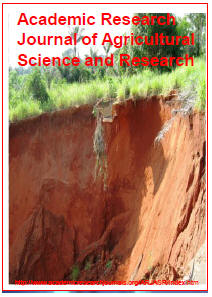| ARJASR |
Academic Research Journal of
Agricultural Science and Research |
||||||||||||||||||||||
|
Academic Research Journal of Agricultural Science and Research Vol. 2(5), pp. 67-75. September, 2014. ISSN: 2360-7874 ©2014 Academic Research Journals Full Length Research Runoff-infiltration processes and some physical properties of Degraded Ultisol under different soil and crop management practices in Nsukka, South Eastern Nigeria.
*Azukaa, C.V. and Obia, M.E
aDepartment of Soil Science, University of Nigeria, Nsukka *Coresponding Author: Azuka, C. V. E-mail: vin4christ2008@yahoo.com
Accepted 29 August 2014
Information on runoff and
infiltration processes is important for sustainable management and
conservation of soil and water resources for increased productivity
on Nigerian agricultural lands. A research was conducted in the
runoff plots (20 m x 3 m) at the University of Nigeria Nsukka
Teaching and Research Farm to evaluate runoff and some hydrophysical
properties of Nkpologu sandy loam soil under different cover and
soil management practices. The management practices were bare fallow
(BF), groundnut (GN), and sorghum (SM) cultivation with 10 t/ha
poultry manure. Soil samples for analysis were taken at 0-15 cm
depth at the end of each cropping season. Runoff and infiltration
measurement were done under different soil and crop management
practices. There was significant (P < 0.05) effect of soil and crop
management practices on bulk density (BD), total porosity (TP), and
macro-porosity (MP), except micro-porosity (MIP). The highest values
for BD (1.61 kgm-3), TP (49.9 %), MP (6.42 %), and MIP (42.85 %)
were obtained under the BF. The lowest BD (1.35 kgm-3) and MP (6.42
%) was recorded under GN, whereas SM recorded the lowest TP (42.10
%) and MIP (36.58 %). The soil and cover management practices
significantly influenced the infiltration characteristics, runoff,
and soil loss measured (P < 0.05). The final steady infiltration
rates ranged from 287 mm h-1 under BF to 468 mm h-1 under GN cover
plot, while the cumulative infiltration at the end of 2 hours ranged
from 14,460 mm under the BF to 64,500 mm under the SM plot. The
highest runoff and soil loss values respectively for both monthly
(8.72 mm; 661 kgha-1) and daily (1.554 mm; 126 kgha-1) evaluations
were obtained under the BF whereas the lowest values for monthly
(1.95 mm; 31 kgha-1) and daily (0.38 mm; 5 kgha-1) evaluations were
obtained under GN. The study has shown that this soil is fragile,
erodible, and susceptible to different forms of degradation,
especially soil erosion. Adequate soil and crop cover management
practices are indispensable to minimize further degradation, and to
enhance sustainable management of soil and water resources for
improved productivity.
Cite this article as:
Azuka CV, Obi ME
(2014). Runoff-infiltration processes and some physical properties
of Degraded Ultisol under different soil and crop management
practices in Nsukka, South Eastern Nigeria. Acad. Res. J. Agric. Sci.
Res. pp. 67-75
|
|
|||||||||||||||||||||
